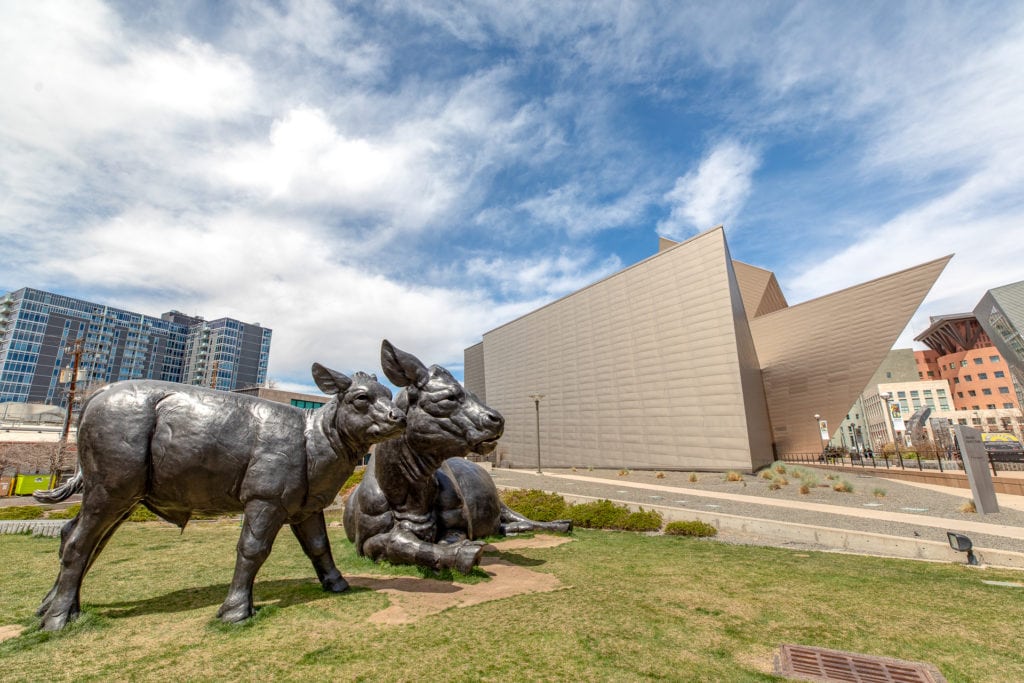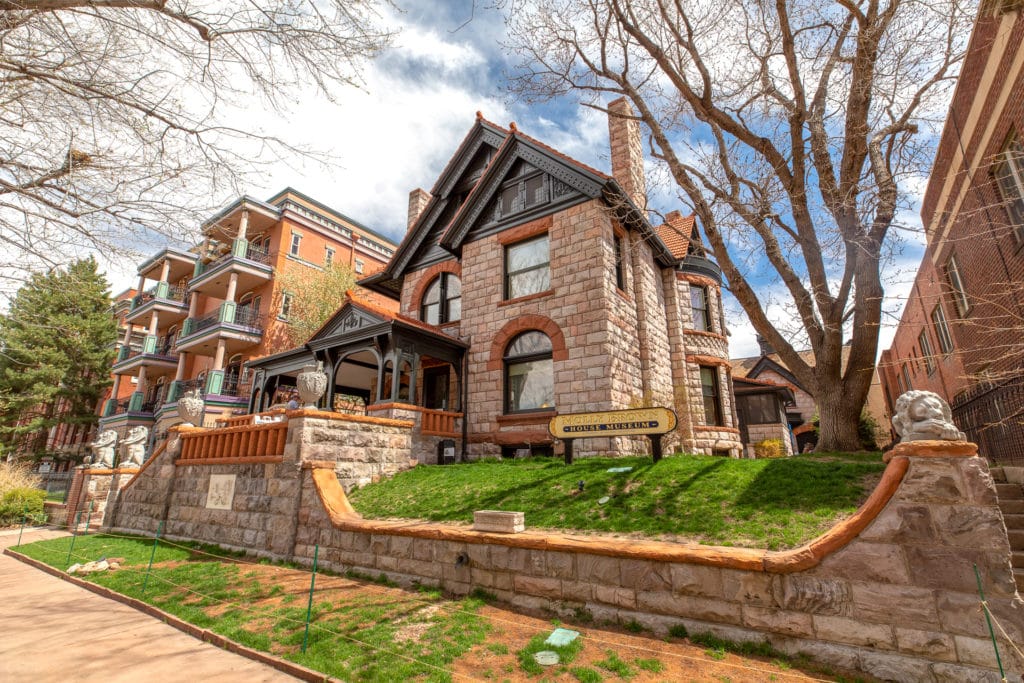A quintessential Denver bluebird sky paints the horizon as my husband Will, our 1-year-old daughter Liliana, and I slowly saunter down the sidewalk on 12th Street. Today, Liliana is particularly captivated by the massive bronze statues located at Martin Plaza next door to the Clyfford Still Museum.
As a feature of the Denver Art Museum (DAM), these statues are dubbed “Scottish Angus Cow and Calf” and they are massive, weighing nearly five tons. Even the artist Dan Ostermiller appreciated their larger-than-life size when he played a practical joke on his secretary by placing her desk inside one of the cows.
Since Liliana stands at a mere 33 inches, the cow’s 13 feet must feel gigantic. Nevertheless, she is delighted with their big eyes and wide nostrils. It doesn’t matter if you are a 1-year-old or a 71-year-old; it is easy to feel inspired when exploring Denver’s Golden Triangle Creative District.

Located just south of downtown and directly west of Capitol Hill, the Golden Triangle is one of Denver’s oldest neighborhoods. Aptly named, it is shaped like a triangle with Colfax Avenue as the north boundary, Speer Boulevard to the west and south, and Broadway as the east boundary.
As a Colorado native, I visit the area multiple times per year for various events at Civic Center Park. The park is beautiful in the spring and summer with all of the colorful flowers, but my favorite time to visit is to enjoy Civic Center EATS. Every year from May through early October on Tuesdays, Wednesdays, and Thursdays, the park fills with food trucks, vendors, and live music from 11 a.m. to 2 p.m. For locals or visitors, it is an awesome way to spend the lunch hour before returning to the daily grind. It is arguably one of the Golden Triangle’s most iconic events.
Civic Center EATS wasn’t around when I was a child but, just like me, the Golden Triangle has evolved and grown over the past 35 years. Today, this district is Denver’s epicenter for creativity, artistry, and cultural development.

Denver Art Museum
The Denver Art Museum houses more than 70,000 works of art divided between 12 permanent collections. One of the more immediately impressive sights is the most recent building added to the DAM. Opened in 2006, the Frederic C. Hamilton Building includes space for both permanent and temporary exhibitions—but the structure is truly a work of art in itself.
Designed by Daniel Libeskind, this building comes to live with angles, cantilevered portions, and jagged protrusions all clad in titanium that beautifully reflects the stunning Colorado landscape. On this beautiful Saturday, we stand outside with Liliana whose eyes practically bug out of her head at the unique shapes. Admission gets you inside the museum, but it is certainly worth taking an extra five or ten minutes to wander around the outside of the building, marveling at its dramatic silhouette.
Kirkland Museum of Fine & Decorative Art
The DAM is not the only reason the Golden Triangle is known for its museums. The 38,000-square-foot Kirkland Museum of Fine & Decorative Art re-opened at its new location in 2018 and shines brightly on the corner of 12th and Bannock Streets. The facade is made from bumble bee-yellow bars of terra cotta mixed in with glass bars throughout. The effect is brilliant—especially for a toddler who spent at least 20 minutes trailing her hands along the wall, marveling at its color—but the interior is even better.


The Kirkland Museum takes a unique approach to presentation, immediately noticeable upon entry. The paintings, sculptures, and decorative art are displayed in “salon style.” My personal favorites are the composed vignettes—scenes designed to take you back to a particular place or time. For example, if the museum is displaying Art Deco furniture, they will create a vignette complete with a phone, a lamp, and other accessories from that time period. For the visitor, the result is captivating.
Due to the fragile nature of the salon style of display, children younger than 13 are not allowed in the museum (sorry, Liliana!). Teens from 13 to 17 years old must be accompanied by an adult.
Clyfford Still Museum
Clyfford Still Museum is another integral component of the Golden Triangle’s art scene. It opened in 2011, over 30 years after the death of Abstract Expressionist artist Clyfford Still. When Still passed in 1980, he left behind a will that dictated what to do with his paintings. A portion would go to his wife and the rest to an American city that agreed to build a permanent structure for his works, while promising to never sell or exchange them. In 2004, Denver announced the city would keep the promise in Still’s will and become the forever home for his powerful archives.

Today, the museum is the world’s most intact public collection of any American artist, which means visitors can see nine galleries of Still’s art. Will, Liliana, and I wander throughout the building, pointing out the more vivid works of art to Liliana and allowing her interest to guide our route. Photos and letters from his archives are also on display, creating a quick glimpse into the life and mind of the talented artist.
History Colorado Center
The Golden Triangle’s appeal doesn’t begin and end with its creative vibe—the neighborhood is a hub for Colorado history, too. Located a three-minute walk to the east of the Kirkland Museum sits the History Colorado Center, a history museum worthy of a trip for anyone who wants to learn more about the Centennial State.

Our favorite is the core exhibit, “Colorado Stories.” After 37 years in the state, I am continually fooled into thinking there isn’t much more I can learn—until I visit this exhibit and glean new tidbits of information about my home. For me, exhibits like “Colorado Stories” are crucial for preserving history—like the story of Lincoln Hills, a haven for African Americans who were once barred from outdoor recreation in the state.
As I read through the displays, I consider how much history Liliana will learn in a decade when she is old enough to be in school and how many events she will witness that I won’t be alive to see. Bizarre thoughts, I know, but visiting the History Colorado Center does make me wonder what our baby girl will see in her lifetime.
Molly Brown House Museum
History buffs will also love the Molly Brown House Museum. As a child in Denver, I frequently heard stories about the “Unsinkable Molly Brown,” who inspired Kathy Bates’ character in the 1997 movie Titanic. Today, Margaret “Molly” Brown’s home-turned-museum is tucked away on Pennsylvania Street, next door to a coffee shop and just a few buildings away from a pub.

When looking around the interior, it’s easy to admire the period furniture (I especially enjoy the decorations around Christmas). After visiting this museum, you’ll marvel at the courageous woman who encouraged Lifeboat 6 to turn around and search for Titanic survivors, and who ran for the U.S. Senate in 1914.
Strolling through the Victorian-era home, my husband and I can only hope that Liliana has even half as much gumption as the Unsinkable Molly Brown.

